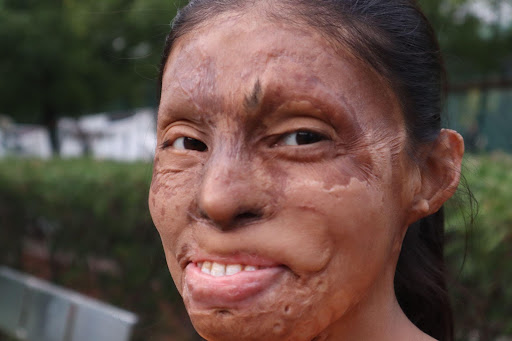A disproportionate gap between the availability of skin donation facilities and the population size, potentially hinders the effective distribution and collection of skin donations across India
In 2008, thirteen-year-old Rupa was attacked with acid in a village near Muzaffarnagar, Uttar Pradesh. “There was no one around. I screamed out in fear and pain and ran straight outside my home. I saw my skin getting darker. It started to shrink, and there was steam coming from it, just like you see in cooked rice. Then I fell unconscious near the entrance,” recalls Rupa, an acid attack survivor, while reliving the horrifying incident.

By the time help arrived, she had already suffered over 40 percent third-degree burns. “My stepmother threw acid on my face while I was deep in sleep. The village head took me to a hospital near Muzaffarnagar, where I had to wait for 16 hours before I received any medical care,” she said.
While the doctors managed to stabilize her, they quickly realized that immediate skin grafting was necessary, but the hospital was not equipped to treat critical burns. The lack of skin for skin grafting allows lead acid to quickly penetrate into the skin, dissolving both the outer layer (epidermis) and the inner layer (dermis). The affected area starts to appear disfigured as the underlying structures that give shape and form to the body’s surface are damaged. This leads to the loss of definition and shape in facial features.
A skin bank is a specialized facility that collects, stores, and distributes donated human skin to burn units for use in medical treatments. The donated skin is processed, sterilized, and prepared to be used as grafts or temporary dressings for patients with severe burns or other complex wounds.
Dr Sunil Keswani, Plastic and Cosmetic Surgeon at National Burns Centre (NBC), in Mumbai said: “Severe burn injuries require immediate care and attention, which most of the time is not provided to them. This is why the allograft procedure (cadaveric skin transplantation) is so important in cases where the burn percentage is more than 40-50 percent when a patient’s own skin is not enough to cover the wounds.”
Cadaveric skin, donated after death, is considered the best and most cost-effective substitute. It serves as a temporary dressing and facilitates the regeneration of the patient’s own skin. With enough skin available in the skin bank, up to 80 percent of these patients can be saved. This highlights the crucial importance of skin donation, as it has the potential to save lives by providing a much-needed resource for burn patients.
Dr. Maneesh Singhal, Professor and Head of the Department of Plastic Surgery at All India Institute of Medical Sciences (AIIMS) in Delhi said:
“In case of burns, skin – the primary protective barrier of the body – is destroyed and the body is exposed to infectious agents. If the burnt area is not immediately covered with some skin substitutes, then patients are prone to infection, fluid loss, and ultimately death.”
According to the 2021-22 annual report by the Ministry of Health and Family Welfare, India registers an estimated 70 lakh burn injuries each year, leading to approximately 1.4 lakh deaths – that’s one death every four minutes.
The report highlights that “death and disability due to burn injury can largely be prevented, provided timely and appropriate treatment by trained healthcare professionals,” is available.
Based on the data provided by Mumbai’s NBC to HealthLEADS, India currently has only 19 skin banks. The banks are not evenly distributed, with Maharashtra having the most of them (five in total), followed by Karnataka with three. Many states have just one skin bank, and some have none at all, which significantly impacts skin donation and transplants.
This reveals a disproportionate gap between the availability of skin donation facilities and the population size, potentially hindering the effective distribution and collection of skin donations across the country.
“In all 19 centers, there are only approx 150-200 donations annually, which is not sufficient,” Dr. Keswani said. “We need at least eight times more donations to meet the demand.”
The scarcity of skin donation facilities, as shown by the low annual donation numbers, exacerbates the challenges faced by burn patients like Rupa. As a result, prompt access to life-saving therapies like urgent skin grafting is frequently hampered, leading to insufficient and delayed care.
Rupa recounts that while doctors managed to stabilize her, they didn’t realize the need for immediate skin grafting. The hospital was not equipped to treat critical burn injuries.
“Initially, nobody could figure out what had happened and what to do next. I was not provided with the right first aid. I kept shouting, and the attending doctor took more than three hours trying to clean the skin with a saline solution,” she said.
“As for first aid, I mean only using cool water (not cold). It should be at normal temperature, ideally running water. You shouldn’t use cold water because it might make the injury worse by causing a spasm in the blood vessels surrounding the area,” she added.
The donated skin is not necessary for reconstructive surgery. It is primarily used for treating active wounds. Traditional treatment involves regular dressing and covering with bandages and can take over 5-6 months for complete healing.
However, this treatment option doesn’t work in case of severe burn injuries. When burn injury is more than 40 percent, the donated skin, which is already harvested and sterilized, is grafted onto the patient’s wound. This method acts as a temporary skin or bandage for the patient’s wound, significantly accelerating healing to the point where a wound that would typically take 4-5 months to heal could be healed in around 30-40 days.
This skin acts as a scaffold for the patient’s own skin cells to regenerate and grow. It helps in reducing pain, fluid loss, and the risk of complications, allowing the underlying tissues to heal more effectively. As the patient’s own skin begins to regenerate, the donated skin is gradually replaced.
In Rupa’s case, she has undergone more than 13 reconstructive surgeries, each requiring the removal of skin from other parts of her body to graft onto the affected area. Despite this, she continues to endure physical and emotional challenges. Had she received immediate treatment and access to skin grafting at the time of her attack, she might have taken lesser time to heal. This emphasizes the critical importance of early intervention and the availability of skin donation banks in providing timely and effective care for burn survivors like Rupa.
The AIIMS Hospital, meanwhile, is expected to get a skin bank this year, according to Dr Maneesh Singhal. However, setting up and running a skin bank is a huge expense, and getting skin donors is a continuous challenge.
Also Read : Skin Donation Banks in India: All you need to know


















Add Comment